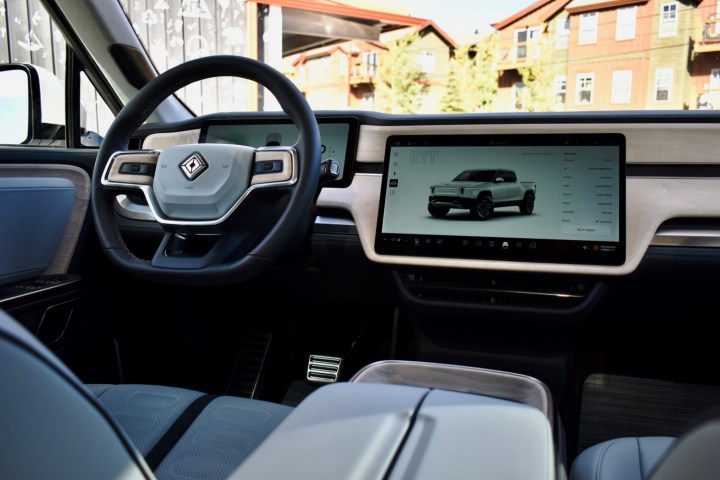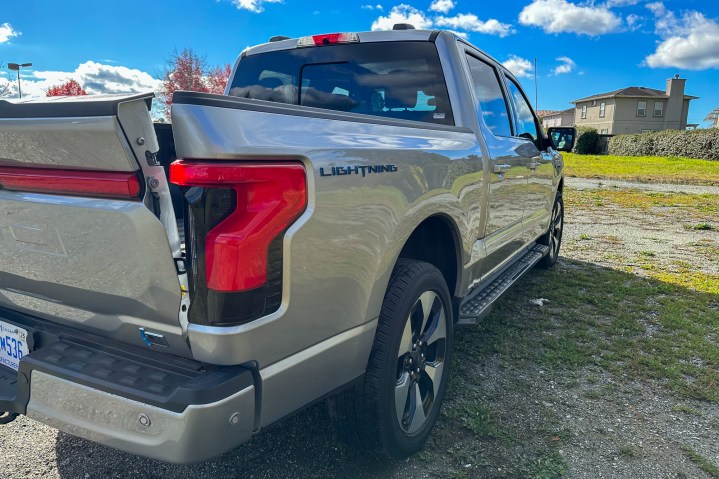All the electric car companies started with crossovers — and they’re now venturing out from there. We’re not only getting a better selection of smaller electric cars, but also bigger ones — and that includes electric trucks. The Rivian R1T has long been considered one of the best electric trucks out there, and for good reason. It’s modern, high-tech, and stylish. But there’s still something to be said for experience — and no one has more experience in building trucks than Ford.
The standard Ford F-150 is known for its incredible sales in the U.S., and Ford is using that name for its electric truck too. The Ford F-150 Lightning takes the best things about the Ford F-150, and combines them with an electric motor and more modern tech.
But which is ultimately a better electric truck — the Rivian R1T or the Ford F-150 Lightning? Here’s what you need to know.
Design
The Rivian R1T is built to offer a new take on truck design — and it really doesn’t look like anything before it. The R1T boasts a light bar along the front, interrupted by two oval headlights that give the truck a unique touch. That wide light bar is matched at the back. Speaking of the back, the bed on the R1T is 54 inches long with the tailgate up, or 83.6 inches with the tailgate down. It’s 51.1 inches wide.

The Ford F-150 Lightning is far from an ugly truck, though. It may not look quite as unique as the Rivian, but it adds on the arguably classic design of the F-150 with a light bar along the front that extends down the sides a little. Because the F-150 Lightning takes its design inspiration from the standard model, you’ll find a faux grille at the front, and more typical-looking taillights in back. The bed on the truck measures 67.1 inches with the tailgate down, and 50.6 inches wide — so it’s a little larger than that on the Rivian.
While some buyers will prefer Ford’s staid styling, if we factor in innovation at all, Rivian is a clear winner here.
Winner: Rivian R1T
Interior and tech
The Rivian R1T is built to offer a modern driving experience, and that extends into the interior of the truck too. That modern experience centers around the 15.6-inch infotainment display, which is coupled with a 12.3-inch digital instrument cluster. Plenty of drivers have rated the R1T’s software as being quite good, especially when compared with the subpar software that most legacy automakers offer.
Apart from the tech, the R1T boasts five seats, with seat heating, ventilation, and power adjustments. It’s safe to say, the driver and passengers should stay relatively comfortable.

The interior of the Ford F-150 Lightning is slightly different. The Lightning also has a 15.5-inch touchscreen for infotainment — however by all accounts, the software loaded onto that screen isn’t quite as impressive as that on the Rivian. It does have one key advantage, though: Unlike the Rivian, the F-150 Lightning supports CarPlay and Android Auto. The Lightning also has five seats, and they’re also quite comfortable, with vinyl upholstery and heating. Manual adjustments come standard, with power-adjustable seats available as an option.
It’s nice that Ford offers CarPlay and Android Auto, but Rivian’s thoughtfully designed software simply does more for the in-cabin experience.
Winner: Rivian R1T
Performance
The Rivian R1T is available with three options. The base model is all-wheel drive through two motors, and it’s able to accelerate from 0 to 60 miles per hour in 4.5 seconds, offering 340 miles of range. It’s a step up from there for the “Performance” dual-motor model, which improves that acceleration time to 3.5 seconds, and offers 350 miles of range. Last but not least is the quad-motor all-wheel drive model, which gets to 60 mph in 3.0 seconds and has a range of 328 miles.
The Rivian R1T is rated as being able to tow up to 11,000 pounds — however you should expect a significant reduction of range if you do so. In fact, Car And Driver noted that switching the truck to Tow mode reduces range from 270 miles to just 103.

The Ford F-150 Lightning is no slouch, either. A number of different models offer range varying between 230 miles and 320 miles, and acceleration to 60 mph sitting at 4.0 seconds at most. The F-150 Lightning can tow up to 10,000 pounds — but again, it’ll severely impact your range.
Safe to say, the Rivian R1T offers a longer range and faster acceleration. It’s the better-performing car here.
Winner: Rivian R1T
Pricing and availability
The Rivian R1T is available right now, however, Rivian notes that delivery may take 16 weeks. It starts at $79,000 for the base model, and ranges up to $87,000 for the Quad Motor AWD model, without additional options.
The Ford F-150 Lightning is also available now, however like the Rivian, deliveries are expected to take a while. At the time of this writing, depending on the model, you could get an F-150 Lightning within between 1.5 and 2.5 months. The truck starts at $51,990, and ranges up to over $100,000 depending on the model you can get.
On starting price alone, Ford wins this one, and it’s no contest.
Winner: Ford F-150 Lightning
Conclusion
It can be hard to determine which electric truck is right for your needs. After all, the Ford F-150 Lightning starts at a much lower price — but it also has a lower range and worse performance overall. If you can afford it, it’s probably worth going for the more modern Rivian R1T — but if you need a little larger of a truck bed, or want to save some cash, the F-150 Lightning is a great electric truck.



